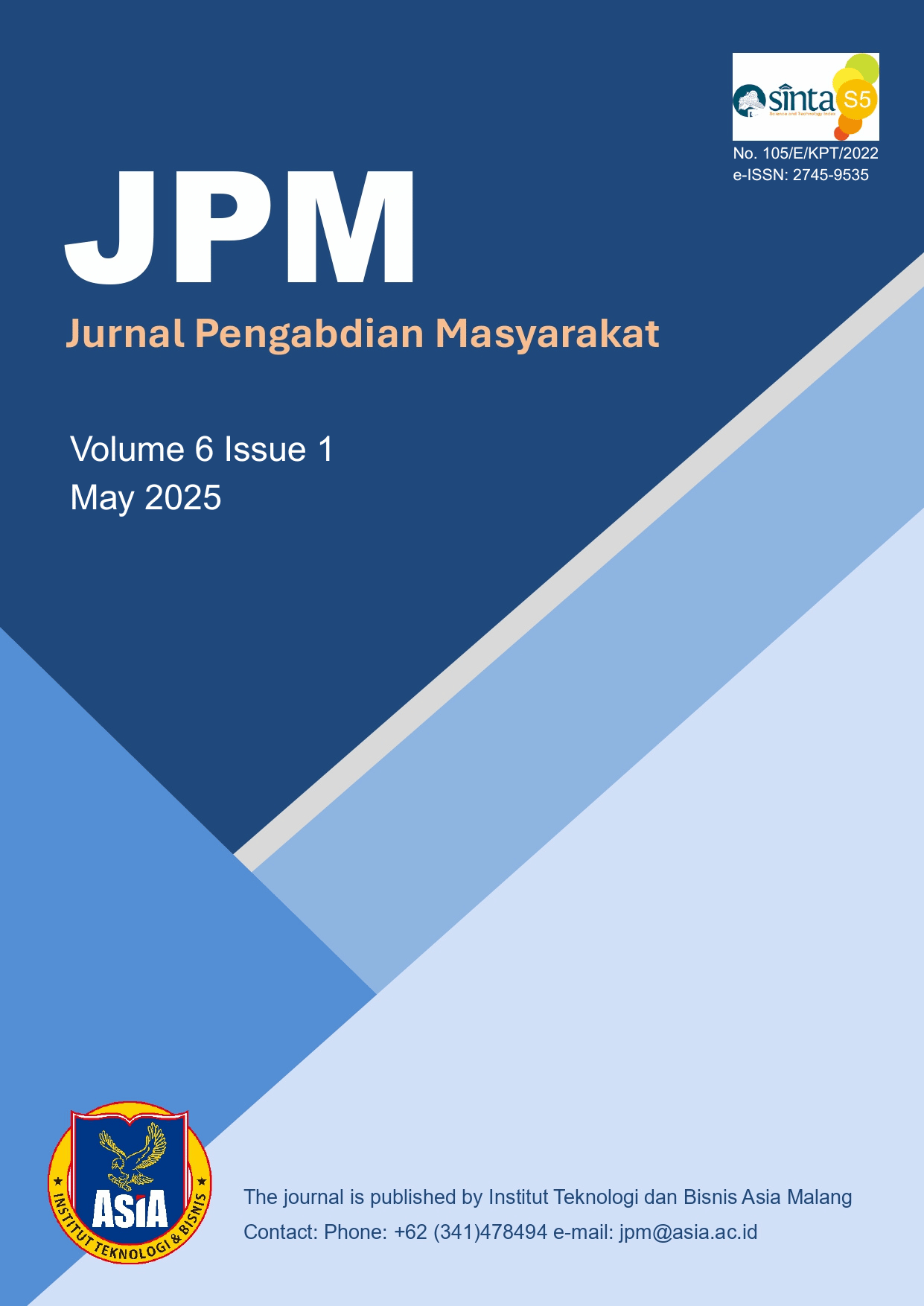Enhancing Student Competence Through Visits to Karangmumus River School to Study Its Ecology Using the River Continuum Concept
DOI:
https://doi.org/10.32815/jpm.v6i1.2465Keywords:
Environmental Awareness, Experiential Learning, River Ecology, River Continuum ConceptAbstract
Purpose: This study aims to enhance student's environmental awareness, particularly regarding river ecology, through an experiential learning approach. The primary activity in this research is a field visit by students to the Karangmumus River School, allowing them to compare theoretical knowledge learned in class with real-world conditions.
Method: The study employs a qualitative method with a descriptive approach. Data was collected through observations, interviews, and student reflections after the field visit.
Practical Application: The findings reveal that the visit significantly improved students' understanding of river conservation and the impact of human activities on river ecosystems. Furthermore, the activity motivated students to contribute to environmental preservation efforts. Thus, integrating classroom theory with field experiences effectively fostered environmental awareness among students.
Conclusion: This study shows that experiential learning through field visits to the Karangmumus River School significantly increases students' awareness of river ecology and environmental conservation.
References
Allan, J. D. (1995). Trophic relationships. In Stream Ecology. https://doi.org/10.1007/978-94-011-0729-7_6
Barmuta, L. A., & Lake, P. S. (1982). Letter to the editor: On the value of the river continuum concept. New Zealand Journal of Marine and Freshwater Research, 16(2), 227–229. https://doi.org/10.1080/00288330.1982.9515965
Canning, A. D., Death, R. G., & Gardner, E. M. (2019). Forest canopy affects stream macroinvertebrate assemblage structure but not trophic stability. Freshwater Science, 38(1), 40–52. https://doi.org/10.1086/701378
Cummins, W. (1974). Function of stream ecosystems. BioScience, 24(11), 631–641. https://doi.org/10.2307/1296676
Dalu, T., Wasserman, R. J., Tonkin, J. D., Alexander, M. E., Dalu, M. T. B., Motitsoe, S. N., Manungo, K. I., Bepe, O., & Dube, T. (2017). Assessing drivers of benthic macroinvertebrate community structure in African highland streams: An exploration using multivariate analysis. Science of the Total Environment, 601–602, 1340–1348. https://doi.org/10.1016/j.scitotenv.2017.06.023
Doretto, A., Piano, E., & Larson, C. E. (2020). The river continuum concept: Lessons from the past and perspectives for the future. In Canadian Journal of Fisheries and Aquatic Sciences (Vol. 77, Issue 11). https://doi.org/10.1139/cjfas-2020-0039
Gholizadeh, M., & Heydarzadeh, M. (2020). Functional feeding groups of macroinvertebrates and their relationship with environmental parameters, case study: In Zarin-Gol river. Iranian Journal of Fisheries Sciences, 19(5), 2532–2543. https://doi.org/10.22092/ijfs.2019.118132
Graça, M. A. S., Ferreira, V., Canhoto, C., Encalada, A. C., Guerrero-Bolaño, F., Wantzen, K. M., & Boyero, L. (2015). A conceptual model of litter breakdown in low order streams. International Review of Hydrobiology, 100(1), 1–12. https://doi.org/10.1002/iroh.201401757
Kuhn, T. (2021). The structure of scientific revolutions. In Philosophy after Darwin: Classic and Contemporary Readings. https://doi.org/10.5840/philstudies196413082
Leopold, L. (1962). The Concept of Entropy in Landscape Evolution. US Government Printing Office. https://books.google.co.id/books?hl=id&lr=&id=YwbDUR6DUrQC&oi=fnd&pg=PA1&dq=Leopold,+L.B.,+and+Langbein,+W.B.+1962.+The+concept+of+entropy+in+landscape+evolution.+US+Government+Printing+Office,+Washington,+D.C.+doi:10.3133/+pp500A&ots=6opcPs0tie&sig=dB-Fm
Magrima Anzani, Y., Krisanti, M., & Wardiatno, Y. (2016). The diversity and density of Plecoptera in the headwaters of Cisadane River, West Java, Indonesia. 126(1), 126–132. http://www.innspub.net
Masese, F. O., Kitaka, N., Kipkemboi, J., Gettel, G. M., Irvine, K., & McClain, M. E. (2014). Macroinvertebrate functional feeding groups in Kenyan highland streams: Evidence for a diverse shredder guild. Freshwater Science, 33(2), 435–450. https://doi.org/10.1086/675681
Mesa, L. M. (2014). Influence of riparian quality on macroinvertebrate assemblages in subtropical mountain streams. Journal of Natural History, 48(19–20), 1153–1167. https://doi.org/10.1080/00222933.2013.861937
Minshall, G. W., Cummins, K. W., Petersen, R. C., Cushing, C. E., Bruns, D. A., Sedell, J. R., & Vannote, R. L. (1985). Developments in Stream Ecosystem Theory. Canadian Journal of Fisheries and Aquatic Sciences, 42(5), 1045–1055. https://doi.org/10.1139/f85-130
Minshall, G. W., Petersen, R. C., Cummins, K. W., Bott, T. L., Sedell, J. R., Cushing, C. E., Vannote, R. L., & Monographs, E. (1983). Interbiome Comparison of Stream Ecosystem Dynamics Published by : Ecological Society of America Stable URL : http://www.jstor.org/stable/1942585 . Interbiome Comparison Of Stream Ecosystem Dynamics ’. 53(1), 1–25. https://doi.org/10.2307/1942585
Neres-Lima, V., Machado-Silva, F., Baptista, D. F., Oliveira, R. B. S., Andrade, P. M., Oliveira, A. F., Sasada-Sato, C. Y., Silva-Junior, E. F., Feijó-Lima, R., Angelini, R., Camargo, P. B., & Moulton, T. P. (2017). Allochthonous and autochthonous carbon flows in food webs of tropical forest streams. Freshwater Biology, 62(6), 1012–1023. https://doi.org/10.1111/fwb.12921
Newman, M. M., Liles, M. R., & Feminella, J. W. (2015). Litter breakdown and microbial succession on two submerged leaf species in a small forested stream. PLoS ONE, 10(6), 1–22. https://doi.org/10.1371/journal.pone.0130801
Pastore, D. M., Peterson, R. N., Fribance, D. B., Viso, R., & Hackett, E. E. (2019). Hydrodynamic drivers of dissolved oxygen variability within a tidal creek in Myrtle Beach, South Carolina. Water (Switzerland), 11(8). https://doi.org/10.3390/w11081723
Ramírez, A., & Gutiérrez-Fonseca, P. E. (2014). Functional feeding groups of aquatic insect families in Latin America: A critical analysis and review of existing literature. Revista de Biologia Tropical, 62(April), 155–167. https://doi.org/10.15517/rbt.v62i0.15785
Rosi-Marshall, E. J., Vallis, K. L., Baxter, C. V., & Davis, J. M. (2016). Retesting a prediction of the River Continuum Concept: Autochthonous versus allochthonous resources in the diets of invertebrates. Freshwater Science, 35(2), 534–543. https://doi.org/10.1086/686302
Southwood, T. R. E. (1977). Habitat, the Templet for Ecological Strategies? The Journal of Animal Ecology, 46(2), 336. https://doi.org/10.2307/3817
Vimos-Lojano, D. J., Martínez-Capel, F., & Hampel, H. (2017). Riparian and microhabitat factors determine the structure of the EPT community in Andean headwater rivers of Ecuador. Ecohydrology, 10(8). https://doi.org/10.1002/eco.1894
Wang, X. (2022). Fatty acid composition of macroinvertebrate scrapers in relation to environmental conditions in subtropical mountain streams. National Library of Medicine, 53(Nov;29), 81037–81047. https://doi.org/10.1007/s11356-022-21265-z
Water, S., Corporation, W., Laboratories, B. N., Cummins, K. W., & Sedell, J. R. (1980). Vannote_1980_Rivercontinuum. 1. https://doi.org/10.1139/f80-017
Winterbourn, M. J., Rounick, J. S., & Rounick, J. S. (1981). Are New Zealand stream ecosystems really different? New Zealand Journal of Marine and Freshwater Research, 15(3), 321–328. https://doi.org/10.1080/00288330.1981.9515927
Downloads
Published
How to Cite
Issue
Section
License
Copyright (c) 2025 Ahmad Shiddiq Mulyanto, Merinda Margaret Kaunang, Fenty Fauziah, Fitriansyah, Bun Yamin, Muhammad Harry Rahmadi

This work is licensed under a Creative Commons Attribution 4.0 International License.





















